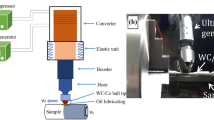Abstract
A new damping method was developed not only as a testing tool to investigate in situ deformation under stress, but also as a processing method to superplastically deform ceramics. The specific damping capacity (SDC) at low frequencies (<0.2 Hz) decreased with increasing frequencies, which matched previous internal friction results. However, at higher frequencies (0.2–5 Hz) SDC increased with frequencies, which was explained by a new internal frictional heat mechanism. Three different ceramics: a non-superplastic one and two superplastic ones with different activation energies, showed the same behavior at the high frequency damping tests (1–5 Hz). From these results, it was deduced that a cyclic load at high frequencies, superimposed on a static one, has a great potential to enhance superplasticity by specifically heating up grain boundaries from internal frictional heat.





Similar content being viewed by others
References
Nieh TG, Wadsworth J, Wakai F (1991) Inter Mater Rev 36:146
Sherby OD, Wadsworth J (1985) Mater Sci Tech 1:925
Wakai F, Sakaguchi S, Matsuno Y (1986) Adv Ceram Mater 1:259
Hwang SL, Chen IW (1994) J Am Ceram Soc 77:2575
Nieh TG, Wadsworth J (1990) Acta Metall Mater 38:1121
Wu MY, Wadsworth J, Sherby OD (1987) Metall Trans A 18A:451
Kim KN, Hiraga K, Morita K, Sakka Y (2001) Nature 413:288
Roebben G et al. (1998) Acta Mater 46:4711
Pezzotti G (2003) J Non-crystal Sol 321:37
Roebben G et al. (1997) Rev Sci Instrum 68:5411
Gadaud P, Guisolan B, Kulik A, Schaller R (1990) Rev Sci Instrum 61:2671
Lakki A, Schaller R, Carry C, Benoit W (1999) J Am Ceram Soc 82:2181
Cai B, Zhou H, Zhang P, Kong QP (1999) Phys Stat Sol A 172:63
Nowick AS, Berry BS (1972) Anelastic relaxation in crystalline solids. Academic, New York, pp. 52–73
Rouby D, Penns O, Reynaud P (2001) in Krenkel W, Naslain R, Schneider H (eds) High temperature ceramic matrix composites Weinheim, New York, pp. 429–439
Lakki A, Schaller R, Nauer M, Carry C (1993) Acta Metall Mater 41:2845
Daraktchiev M, Schaller R (2003) Phys Stat Sol 195:293
Riviere A (2004) Mater Sci Eng A 370:204
Kennedy FE (2000) in Bhushan B (ed) Modern Tribology Handbook. CRC Press, Florida, pp 235–247
Staehler JM, Mall S, Zawada LP (2003) Comp Sci Tech 63:2121
Shuler SF, Holmes JW, Wu X, Roach D (1993) J Am Ceram Soc 76:2327
Zhou X, Hulbert DM, Kuntz JD, Garay JE, Mukherjee AK (2004) Ceram Trans 165:155
Zhou X, Hulbert DM, Kuntz JD, Sadangi RK, Shukla V, Kear BH, Mukherjee AK (2005) Mater Sci & Eng A 394:353
Senda T, Takahashi C, Uematsu S, Amada S (1992) JSME Inter J, Series III, Vibration, Control Engineering, Engineering for Industry 35:660
Popov VL, Psakhie SG, Shilko EV, Dmitriev AI, Knothe K, Bucher F, Ertz M (2002) Phys Mesomech 5:17
Acknowledgements
We thank Mr. D.M. Hulbert and J.D. Kuntz for experimental assistance and Drs. R.G. Duan and G.D. Zhan and Mr. N.A. Mara for helpful discussion. This research is supported by US Office of Naval Research under the grant number N00014-03-1-0148.
Author information
Authors and Affiliations
Corresponding author
Appendix I Estimation of temperature increase at grain boundaries under biased cyclic loading
Appendix I Estimation of temperature increase at grain boundaries under biased cyclic loading
Temperature increase by internal friction heat can be estimated from tribology theories. Suppose the tribology theory remains valid in the microscopic scale (sub micrometer), and the temperature increase ΔT [19] is:
in which, the heating rate μ is the friction coefficient, P is the normal stress, ν is the relative velocity, l is width of the sliding band, k is thermal conductivity, ρ is the density, and C p is the specific heat capacity. In our tests,
For TZ3Y specimens in our test, the average grain size is about 300 nm, the sample size is 3 × 3 × 5 mm, \(l{\hbox{ = 300}}\;{\hbox{nm $ \times $ }}\frac{{{\hbox{3}}\,{\hbox{mm $ \times $ 3}}\;{\hbox{mm}}}} {{{\hbox{300}}\,{\hbox{nm $ \times $ 300}}\,{\hbox{nm}}}}{\hbox{ = 30}}\,{\hbox{m}}\) Supposing the displacement is caused by uniform grain boundary sliding, for a 10 MPa as stress amplitude and 20 MPa as static stress, the relative velocity was determined to be ν = 1.0 × 10−5 ms−1 from the actual displacement amplitude at f = 1 Hz and ν = 2.0 × 10−5 ms−1 at f = 2 Hz, we have ΔT = 50 °C for f = 1 Hz and similarly, we have ΔT = 71 °C for f = 2 Hz.
Rights and permissions
About this article
Cite this article
Zhou, X., Mukherjee, A.K. Superplasticity by internal frictional heat under biased cyclic loading. J Mater Sci 42, 5217–5222 (2007). https://doi.org/10.1007/s10853-006-0456-2
Published:
Issue Date:
DOI: https://doi.org/10.1007/s10853-006-0456-2




